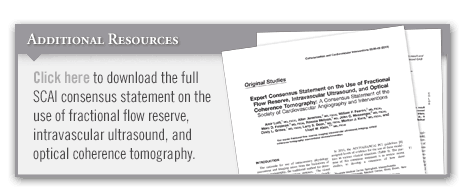As technology has advanced, intracoronary physiology assessments and imaging are increasingly being used in the management of patients with severe coronary stenosis. This shift in diagnostic use has been necessitated because of limitations when interpreting coronary angiography, which has been the traditional method for determining the severity of coronary stenosis. “The diagnostic effectiveness of coronary angiography is limited by inter-observer variability, even among the most experienced angiographers,” says Lloyd W. Klein, MD, FSCAI. Fortunately, several additional adjunctive techniques have emerged to further assist clinicians who care for these patients.
In recent years, three diagnostic procedures have emerged that can improve decisions for coronary revascularization, guide the performance of PCI, and optimize procedural outcomes. These procedures include: 1) fractional flow reserve (FFR), 2) intravascular ultrasound (IVUS), and 3) optical coherence tomography (OCT). FFR is used to determine the functional significance of a coronary stenosis. IVUS offers excellent visualization of the intraluminal and transmural coronary anatomy. OCT was approved for use in the United States in 2010. It further improves vascular visualization to help determine causes of blood clots and blockages of critical blood flow.
“There is now persuasive evidence regarding intra-coronary diagnostic lesion assessments using these adjunctive diagnostic procedures,” adds Dr. Klein. “However, research suggests that these techniques are underutilized in contemporary practice.”
Consensus Recommendations
In 2011, the American College of Cardiology, American Heart Association, and Society for Cardiovascular Angiography and Interventions (SCAI) released joint guidelines for using PCI, but a deeper analysis of the available literature was necessary to guide clinicians when using FFR, IVUS, and OCT. In 2013, SCAI issued a consensus statement that reviewed recent studies on these diagnostic modalities to develop a consensus of how these procedures are best utilized in practice. The statement is also intended to support how FFR, IVUS, and OCT are incorporated into guidelines and appropriate use documents.
Published in Catheterization and Cardiovascular Interventions, the SCAI expert consensus statement reviewed each technology and evaluated proven benefit to patients. Categorizing these modalities in this manner offers physicians perspective on best practices and guides the use of each test by summarizing the conditions for which these procedures have definite benefit, when no proven benefit has been demonstrated, and where there may be potential for benefit once additional studies become available (Table).
“Physicians will find these recommendations helpful as they use these techniques in the care of patients with more complex disease and in situations in which diagnostic tests seem to contradict one another,” says Dr. Klein, who served as chair of the SCAI writing committee. “For patients who can potentially benefit from FFR, IVUS, or OCT, this guidance offers physicians the parameters to ensure they’re put to the best possible use based on current evidence.”
Examining Potential Benefits
There is now substantial long-term outcomes data showing that there are benefits with using FFR-guided decision making. “In patients with complex disease, angioplasty with FFR measurement can improve outcomes and save resources when compared with using PCI guided by angiography alone,” Dr. Klein says. “Knowing FFR measurements may also help guide decisions on whether to perform PCI or CABG.” In addition, FFR measurements may determine whether patients need urgent in-hospital care or medication alone. It is of particular value when the angiographic severity of the stenosis is intermediate or ambiguous.
Dr. Klein says that of the three diagnostic modalities, IVUS has the most mature data. “IVUS can be used to accurately determine how well stents are placed, ensuring that the devices are properly deployed based on a patient’s anatomy,” he says. The SCAI consensus document notes that IVUS can be used to assess left main stenosis severity to help determine if revascularization will be required but cautions that it not be used in isolation to determine the severity of stenoses in other locations.
OCT is one of the newest additions to the diagnostic armamentarium, and Dr. Klein says that most studies examining its efficacy are descriptive in nature. Despite the lack of clinical data on OCT, the modality appears to be beneficial in determining how well stents are placed. It also offers the possibility of improved imaging when compared with IVUS. The SCAI recommendations note that OCT can be useful in assessing changes in coronary plaque.
More to Come
According to Dr. Klein, FFR is being used increasingly in patients with coronary disease and may someday become the standard of care. “As FFR continues to be used more frequently, it will be important for researchers to reexamine the efficacy of angiograms as the current standard for making revascularization decisions,” he says. He also notes that there is hope that FFR can be used to guide all revascularization procedures, which in turn may reduce the need for surgery, a potential effect that could dramatically impact the future of care.
In the meantime, Dr. Klein recommends that clinicians use the SCAI expert consensus document as a reference tool when caring for heart disease. “FFR, IVUS, and OCT are likely to be used more frequently in the future, but it’s also important to recognize
when these modalities will be of little value. The SCAI consensus document outlines such scenarios. These clarifications are helpful and necessary to improve
care and outcomes.”




 admin
admin